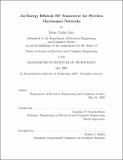An energy efficient RF transceiver for wireless microsensor networks
Author(s)
Daly, Denis Clarke
DownloadFull printable version (904.0Kb)
Alternative title
Energy efficient radio-frequency transceiver for wireless microsensor networks
Other Contributors
Massachusetts Institute of Technology. Dept. of Electrical Engineering and Computer Science.
Advisor
Anantha P. Chandrakasan.
Terms of use
Metadata
Show full item recordAbstract
A wireless microsensor network consists of a group of sensor nodes that are deployed remotely and used to relay sensing data to the end-user. Due to their remote deployment, large scale wireless sensor networks require a low-power, energy efficient transceiver that can operate for years on a single battery. Existing wireless transceivers designed for low-power wireless standards like IEEE 802.15.4 have difficulty meeting such stringent energy requirements. Thus, a custom on-off keying wireless transceiver for sensor networks has been designed in a 0.18-[micro]m CMOS process. Power savings are achieved by using an envelope detection based architecture that leverages SAW components and through advanced circuit techniques. The transceiver is power-aware, able to scale power consumption in response to operating conditions. Circuit optimizations are made in both high frequency and baseband circuits to minimize the number of off-chip components and to achieve optimal energy efficiency. A thorough comparison of radio-frequency tuned and untuned gain stages shows that untuned gain can offer energy efficiency advantages in many situations. The transceiver operates in the 900 MHz ISM band at a data rate of 1 Mbps. The receiver's sensitivity is scalable from -37 dBm to -71 dBm with power consumption ranging from 500 [micro]W to 2.4 mW. (cont.) These power levels correspond to an energy per bit ratio of 0.5 to 2.4 nanojoules per bit, more than ten times smaller than the ratio of typical wireless receivers. The transmitter supports output power levels from -10 dBm to -1 dBm and has a maximum power efficiency of 11%.
Description
Thesis (S.M.)--Massachusetts Institute of Technology, Dept. of Electrical Engineering and Computer Science, 2005. This electronic version was submitted by the student author. The certified thesis is available in the Institute Archives and Special Collections. Includes bibliographical references (p. 81-86).
Date issued
2005Department
Massachusetts Institute of Technology. Department of Electrical Engineering and Computer SciencePublisher
Massachusetts Institute of Technology
Keywords
Electrical Engineering and Computer Science.